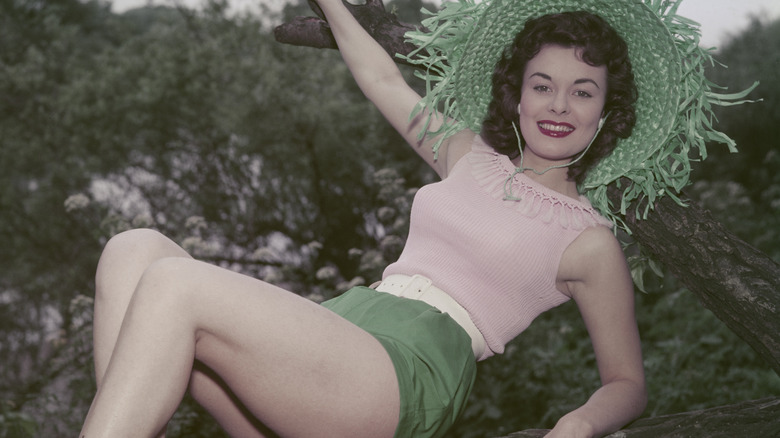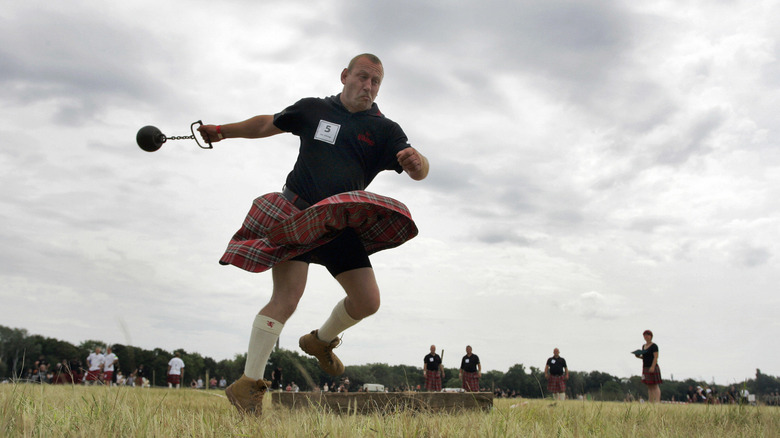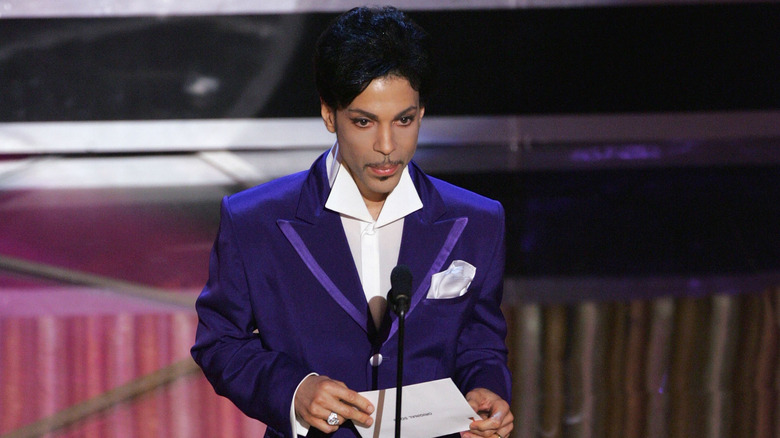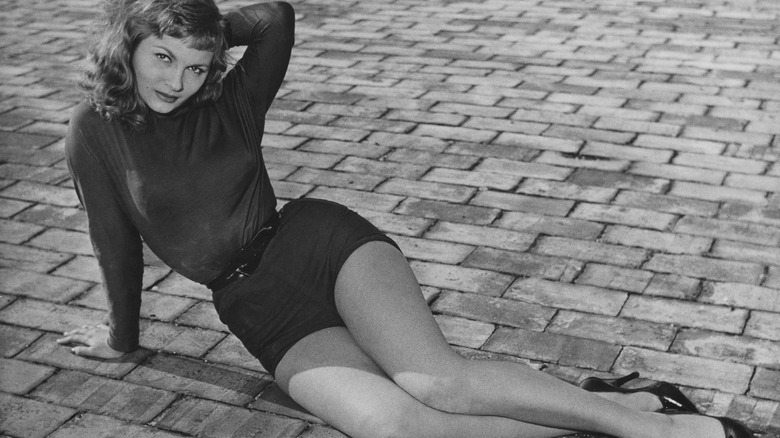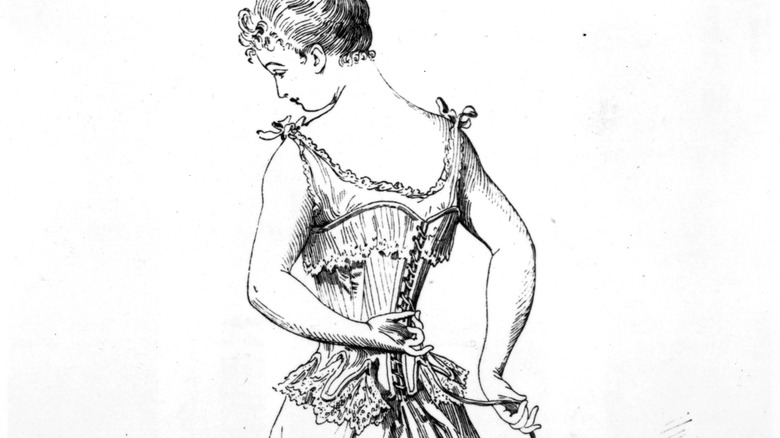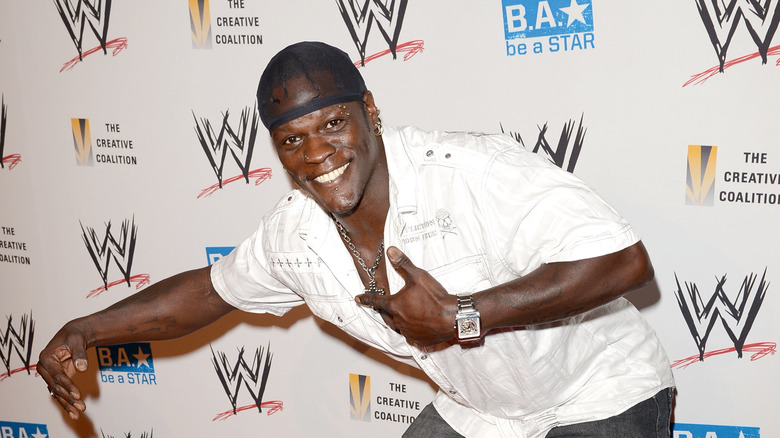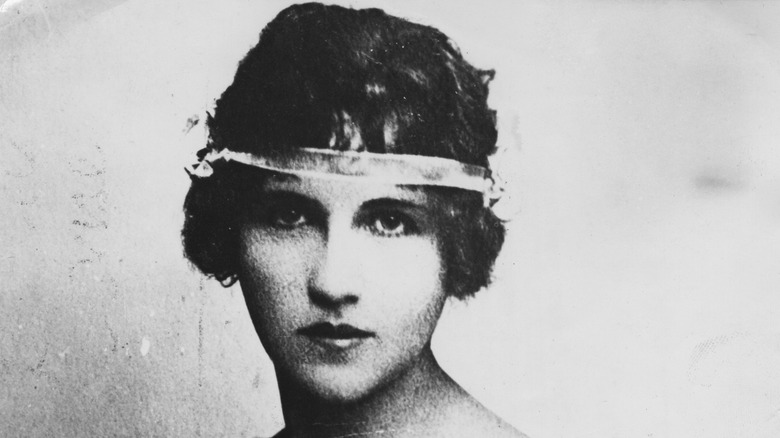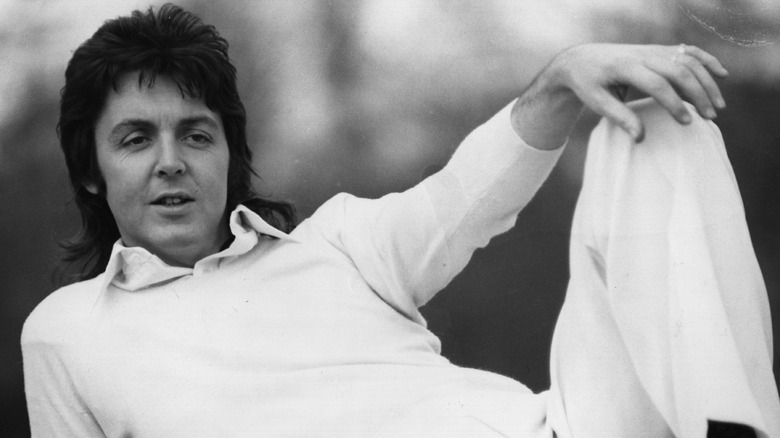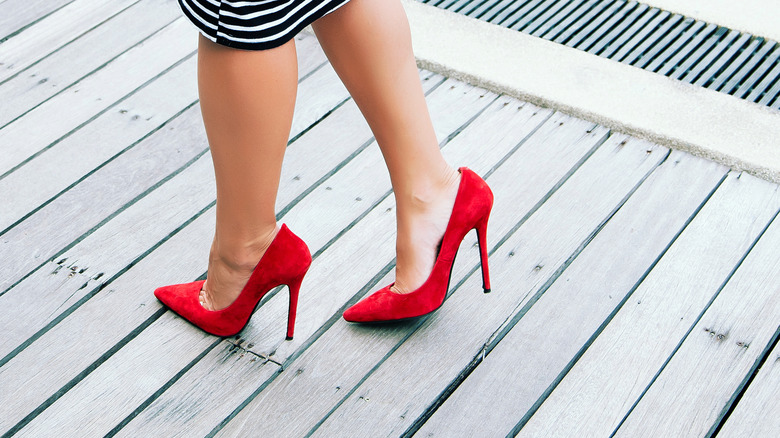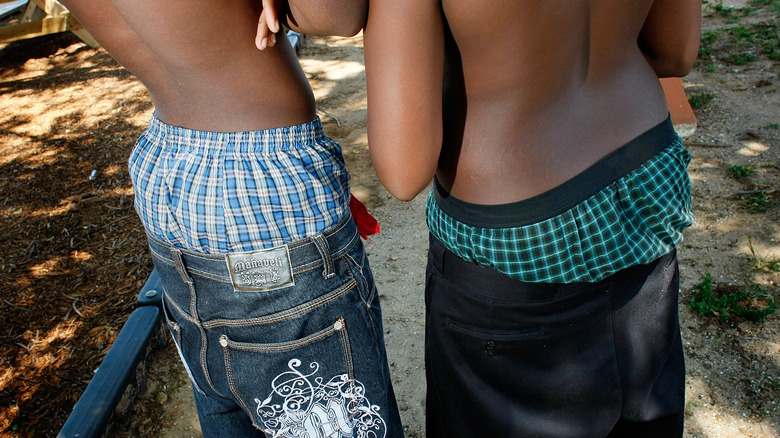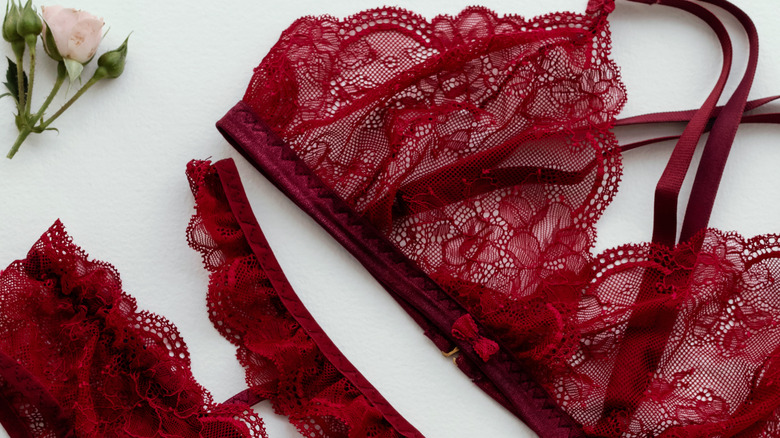Fashion Trends That Were Banned Throughout History
Fashion trends go in and out of style, but sometimes the reason for a particular trend's fall from grace is because no one is allowed to wear it. Believe it or not, some of the most iconic looks of all time have been banned at some point in history. Sometimes the ban is for political reasons and sometimes the reason is just plain silly. Taking a look at some of history's most baffling banned fashion trends tells us not just about the times, but it also proves that there's more to fashion than just looking good.
While many of the styles on this list have outlived their bans and are now in society's good graces, some of them have only been prohibited recently. From clothing to hairstyles, even some of the most beloved fashions in history haven't been immune to being banned. Here is a look at some of the most controversial trends in history that have been subject to banning.
Pants
Women wearing pants is a fairly recent development in the history of fashion. The reason it took so long for them to become a staple in women's wardrobes, though, is more complex than pants simply taking a while to come into vogue. Women have actually had to fight for the right to wear pants as they were traditionally considered a men's fashion item. Pants for women first started becoming mainstream after World War I, as many women had grown accustomed to wearing pants to the factory jobs they took to replace the men who went to war.
In 1939, Vogue began showcasing women wearing pants, spurring the growth of the style further. Also helping popularize the look was actress Katherine Hepburn. By the mid-20th century, many women were wearing pants but the fashion was still somewhat controversial and, in some cases, banned. Universities were allowed to prohibit female students from wearing pants until 1972. There were rules until 1993 prohibiting women from wearing pants on the floor of the U.S. Senate. Incredibly, it wasn't until 2016 that British Airways cabin crew members were finally allowed to wear pants to work after a two-year battle with the airline.
Tartans
Ask someone to describe a traditional Scottish men's outfit and they'll likely describe a plaid kilt. These kilts, made from a type of woven cloth called tartan, are such a powerful symbol of Scottish identity that, in the 18th century, tartans were even banned for a time. The Dress Act of 1746 was an attempt to punish Highland Scots after many of the clans in the Scottish Highlands participated in a series of unsuccessful uprisings which attempted to restore the Scottish Stuart dynasty to the British throne.
After the rebelling clans suffered a bitter defeat at the Battle of Culloden in 1746, the British government wanted to prevent any future uprisings. They then passed the act, which made it illegal to wear tartans, along with other traditional clothing. This was done in the hope that it would subdue the rebellious Scottish clans by stripping them of their cultural identity, thereby weakening the clans and preventing them from rising up again.
The ban on tartans remained in place until 1782. While the tartan lives on, the ban, along with the brutal defeat, did weaken the clan system. The Battle of Culloden marked the end of the last major uprising.
Purple clothing
In the 14th century, England passed a sumptuary law called A Statute Concerning Diet and Apparel. The law governed what people ate and wore. Poor families, for example, were forbidden from wearing silk and fur, while only lords could wear a jacket that revealed their knees. The law also regulated the wearing of the color purple, which was reserved for royals. This law recalled ancient Roman law which also forbade the general population from wearing purple. Romans who violated the decree were subject to the death penalty.
While historical laws might have prohibited commoners from wearing purple, it's unlikely that the average person would have been able to afford a purple garment anyway. Purple dye was notoriously difficult and expensive to produce for much of history. It wasn't until the mid-19th century that synthetic purple dye was produced, making the hue widely available to the general public for the first time.
Kingfisher feathers
It's hard to believe that something as innocuous as feathers could be prohibited, but that's what happened to kingfisher feathers in China during the Ming dynasty. The feathers were prized for their beauty and quite difficult to obtain, making them highly coveted as decorations as well as extremely valuable. They were so beautiful that they were even worked into metal jewelry in an art form known as tian-tsui. Kingfisher feathers were also woven into headdresses that were worn by noblewomen at weddings and special occasions.
During the Ming dynasty, austerity measures were put into place. Many goods during this era were prohibited to the average citizen. Among them were gold thread and certain fabrics and patterns. The opulent kingfisher feathers were also kept out of the hands of all but the most high-ranking royals and government officials during this time. Even after austerity measures were relaxed, kingfisher feathers still remained the privilege of the highest classes of society.
Shorts
Who wears short shorts? If 20th century sartorial sticklers had their way, no one would be wearing the abbreviated garment. NPR cited several historical newspapers that covered cities that have tried to abolish shorts over the years. In 1938, Honesdale, Penn. banned shorts on the grounds that partially uncovered legs were considered immodest, reported the Moberly Monitor-Index. The New York Times reported that the city of Monahans, Texas prohibited women from walking down public streets in shorts in 1944. The following year, several municipalities in Illinois also prevented women from wearing shorts in public, wrote the Associated Press. In 1959, the same paper wrote that Plattsburgh, N.Y. banned anyone over the age of 16 from wearing shorts in public. Offenders could be fined $25 or imprisoned for 25 days.
The battle against shorts continued on. Notably, it wasn't until the 1980s that the United States Golf Association finally lifted a ban on golfing shorts.
Corsets
Possibly one of the most oppressive fashions of all time, corsets helped women achieve a smaller waist and impeccable posture. That doesn't sound too bad, but corsets also restricted a wearer's ability to move and could also make it difficult to breathe. In the 19th century, several Eastern European countries banned the undergarment, but it would take America longer to follow suit. Surprisingly, it wasn't the discomfort brought on by corsets that led to their ban in the U.S. in the early 20th century. Instead, it was a war that helped reshape women's shape wear.
During WWI, there was a shortage of metal. As corsets at this time were made primarily from this material, the War Industries Board, a wartime government agency, asked women to stop wearing corsets. By giving up their corsets, American women managed to direct 28,000 pounds of metal towards the war — enough to build a battleship.
This temporary ban helped bring about the downfall of the corset as, by the time the metal was no longer needed for the war, women had adjusted to a more comfortable lifestyle. Within a few years, corsets were mostly replaced by the modern bra.
Durags
The durag is a rag or scarf worn to cover hair and is most commonly associated with black men. The look became popular in the 1970s as a way of keeping hair in place and frizz-free. From there, it evolved into a fashion staple and, in modern times, has been sported by celebs like Rihanna and Jay-Z.
In 2018, a Massachusetts charter school, where most durag-wearers were young black men, banned students from wearing them. The school's dean of students and school culture, Shauna-Kaye Clarke, apparently believed the trend was "a direct component of the school to prison pipeline." In an e-mail to the student body (via The Daily Item), Clarke wrote, "Unfortunately, they are also reflective of some gang culture." She continued, "And they can recede your hairline. That's not setting you up for success."
Critics said that black students were being unfairly targeted by the policy, and students felt like they were having their culture censored. The school eventually gave in to pressure, partially repealing the ban by allowing students to wear the head covering on campus as long as they were removed by the time classes started.
Bobbed hair
Even today, if a woman cuts off all her hair, it's considered a bold (and often risky) fashion choice. There was a time, however, when a woman cutting off her hair could actually face pushback from society. Bobbed hair started cropping up in the early 20th century, but the style really became popular in the 1920s. Short hair wasn't just a fashion trend, but it was also a way of defying long-held gender norms.
"I consider getting rid of our long hair one of the many little shackles that women have cast aside in their passage to freedom," actress Mary Gordon told Pictorial Review in 1927 (via Fashionista). "Whatever helps their emancipation, however small it may seem, is well worth while."
Not everyone was on board with women declaring their emancipation. Preachers spoke against the trend, and pamphlets warning of the supposed health risks involved with bobbed hair were distributed. Many schools even banned young women from cutting off their hair.
Western hairstyles
In Iran, hairstyles are often even more restrictive than in the United States. There, western hairstyles have been banned since 2010 as they are thought by some people to be anti-Islamic. Banned hairstyles include the mullet and the ponytail. The country took things further in 2015, banning other haircuts and beauty trends that were said to be "devil worshiping," according to The Guardian, although they didn't provide a list of hairstyles that fit that criteria.
"Devil-worshiping hairstyles are forbidden," the head of the country's barbers' union, Mostafa Govahi, told the press (via The Guardian). "Any shop that cuts hair in the devil worshiping style will be harshly dealt with and their [license] revoked. Tattoos, solarium treatments and plucking eyebrows [for men] are also forbidden."
In a separate interview, Govahi said that Iran's barbers have a list of approved hairstyles that can be given to men. "I won't allow such wrongful western styles as long as I'm in this position," he said.
High heels
High heels might be stylish, but they aren't exactly comfortable. That's not the reason they're banned, though, at least not in the city of Carmel, Calif. There, you can't wear heels with a base of less than a square inch or heels that are more than two inches high unless you get a permit. The law came into being in 1963 to protect the city from lawsuits as tree roots pushing through the pavement make it uneven and thus easy to trip on. Fortunately, the permits are available for free, and, even if you don't get one, the police don't issue citations for heel wearers.
High heel fans aren't so lucky in Greece. In 2009, officials banned high heels from being worn at ancient sites because of the damage the shoes can cause.
In some cases, high heel bans have been about preventing women from being forced to wear high heels. In 2019, Alberta, Canada made it illegal for companies to require employees to wear any shoes that could pose a safety risk, effectively banning the mandatory wearing of high heels. The Philippines passed a similar law in 2017, prohibiting companies from requiring women to wear high heels to work.
Leggings
Whether or not you believe that leggings are pants, you likely haven't realized just how heated the debate over the tight clothing trend is. Leggings have been around for decades, but hatred for them didn't reach ban-worthy levels until the 2010s. A lot of the hatred for leggings can be chalked up to the patriarchy. Some people are concerned that the shape-revealing clothes can be too enticing. "I thought of all the other men around and behind us who couldn't help but see their behinds," wrote Maryann White in a letter to the editor of the University of Notre Dame's student paper, The Observer, in 2019. White had attended church services at the university and was scandalized by young women wearing leggings as pants.
In 2012, a school in Canada banned leggings on campus. That same year, a Minnesota school principal wrote a letter to parents complaining about the "distracting" attire and asking them to urge their children to cover up. In 2014, a North Dakota high school took things one step further by comparing students who wear leggings to sex workers.
Sagging pants
People haven't just come down on pants for being too tight, but they have also criticized pants for being too loose. In 2008, the Chicago suburb of Lynwood banned pants worn so loose they dropped below the waist in a style known as "sagging." Other towns and cities across the country quickly followed suit. "It's not right," Eugene Williams, the town's mayor, told the Chicago Tribune. "It's ugly and stupid. Can't you respect my little kid or my mother when you're out? I wouldn't walk around my own house with my pants hanging down — why do I have to accept that out in public?"
In 2011, Florida passed a bill that required schools to discipline students whose pants sagged low enough to show their underwear. That same year, public buses in Fort Worth, Texas began turning away passengers wearing sagging pants.
The fight against the trend is ongoing. In 2018, South Carolina lawmakers proposed a bill to outlaw the trend. The following year, police chased a young man for violating a ban on sagging pants in Shreveport, La., opening fire after they saw he was carrying a gun. While the man's death was ruled a suicide, the incident led to demands to repeal the ban. In June 2019, the ban was repealed.
JoJo bows
As far as fashion trends go, hair bows seem innocent enough. Bows have long held a cutesy appeal and are traditionally associated with young girls, although, when they first came into vogue in the 17th century, it was fashionable for both men and women to rock them. In the 2010s, Dance Moms reality star JoJo Siwa brought hair bows into the 21st century with the oversized bows she favors becoming so popular that tweens scrambled to copy the look. Siwa eventually came out with her own line of hair bows dubbed "JoJo Bows."
In 2017, schools across the United Kingdom banned the bows, claiming they're too "distracting" in an educational setting, and Australia followed suit. The ban baffled many parents, but Siwa herself urged her fans to follow their school dress codes. "I think that kids need to listen to their teachers and principals, but at the same time, I think that the fact that my bows are so popular is unbelievable!" she told The Sydney Morning Herald.
Lacy underwear
Perhaps the strangest banned fashion trend on this list is a modern ban on lacy underwear in Russia, Belarus, and Kazakhstan. It's not the provocative nature of the garments themselves that these countries have a problem with. Instead, the ban is a safety measure that was put in place in 2014.
Customs unions put the measures in place in order to protect wearers from skin problems caused by wearing clothing that doesn't absorb enough moisture. Under these measures, clothing that comes in contact with skin must contain at least 6 percent cotton. That's bad news for lace and most other luxury lingerie, most of which is made of less than 4 percent cotton. While the ban doesn't specifically make it illegal to own such clothing, it does bar their import and manufacture.
The de facto ban didn't sit well with the public who quickly took to social media to post pictures of themselves wearing lacy undergarments. Several people were even detained in Kazakhstan after publicly protesting the restriction.
